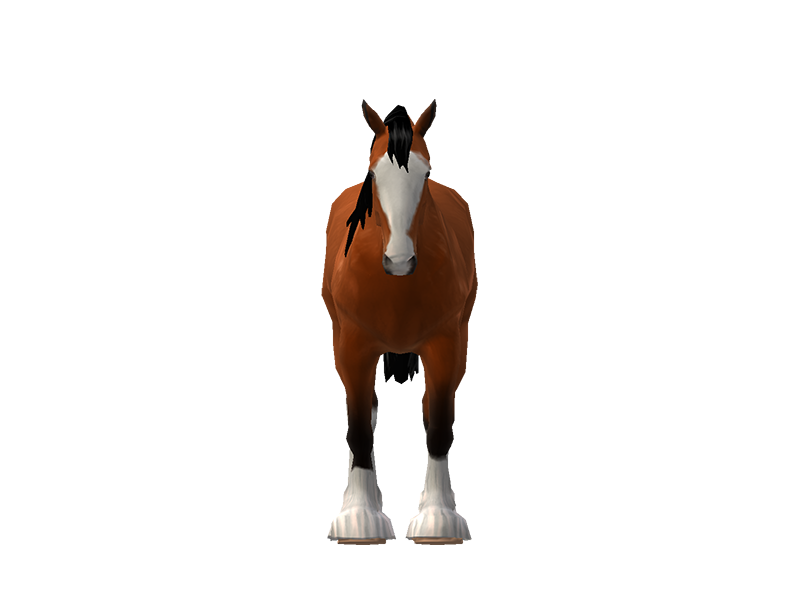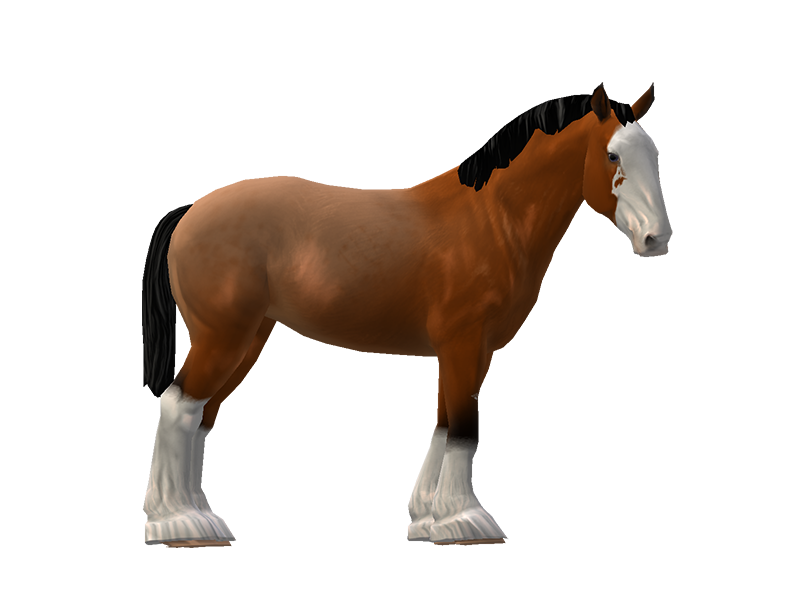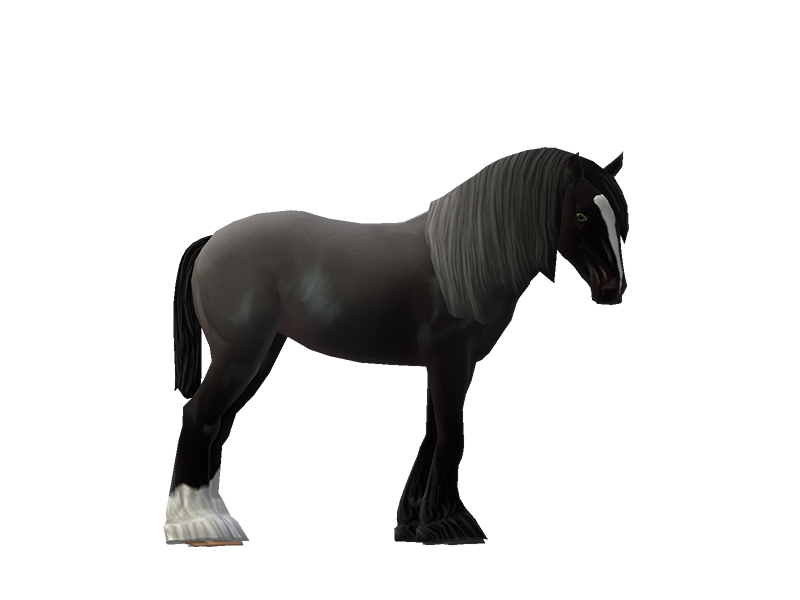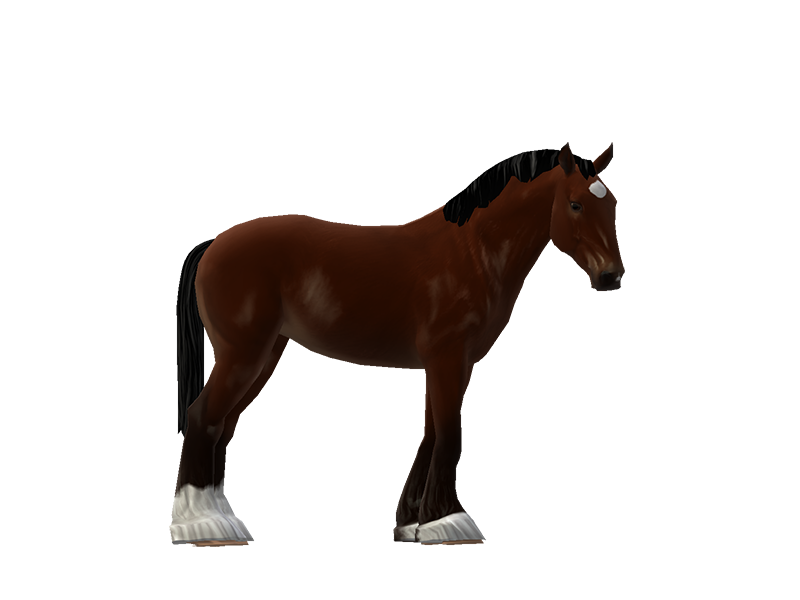Our Massive Real World Equine Reference!
[ INDEX ] Equine Type: Horse Breed: Shire [ PREV ] [ NEXT ]
The Shire is a British heavy draft breed, and is the tallest and largest horse breed in the world. The breed was developed in the different shires of England, hence its name.
The story of the Shire breed begins in the 11th century, when large and heavy Flemish horses, known as the "Great Horses" (Destriers), were brought to England during the Norman Conquest. Great Horses served as cavalry horses because they were strong enough to carry a knight in full armor. During the 16th century, a new breeding policy in England encouraged the breeding of even stronger horses, and as such, English farmers bred the Great Horses to create an even larger horse: the Shire.
During the 17th century, Shire breeders improved the speed of the Shire breed, which made it even more popular. Millions of Shires were used for farm work, forestry work, transportation of goods, towing boats along canal, activating mills for food production, and pulling brewery carts and carriages. The Shire was such a multi-purpose breed, that even the establishment of the railway in England, an act that negatively affected the population of other horse breeds, didn't affect the Shire horse.
The 19th century was the Golden Age of the Shire breed, during which the Shire Horse Society was formed, a studbook was created, and official horse-shows dedicated to the Shire breed were organized, all of which led to further breeding and to the improvement of the Shire breed. It was also during this century that a colossal Shire horse called 'Sampson' was born. Sampson, who was also called 'Mammoth' due to his gigantic size, stood at 21.25hh and weighed 1.5 tons, and is the largest horse who ever lived.
Things went south after World War I, when the gradual introduction of cars, buses, tractors, and other machines, rendered the Shire horses redundant. From a population of over a million horses, only a few thousands were left in the 1960's. Ever since then, breeding of Shire horses continued on a small scale. Over the years it became clear that despite them being tall and weighing up to 1.1 tons, Shires are far more athletic than other heavy draft breeds, and therefore can be used as riding horses.
In order to combine the physical characteristics of the Shire horse with more athleticism, a new subtype of the Shire horse, called the Shire Sport Horse, was created. Any Shire that has one parent who is a Shire horse and one parent who is a horse of a lighter breed that weighs between 350kg and 700kg, is defined as a Shire Sport Horse.
Today, Shires and Shire Sport Horses are used for competitive driving as well as for riding, especially in the field of dressage, in which they excel. In addition, a small number of Shire horses work in farms and forests, pull brewery carts, and compete in ploughing matches and flat races. That said, despite seeming like a popular breed, the Shire is a threatened breed at risk of extinction.
Shire horses have a gentle, social, and cooperative personality. They come in the colors of black, brown, bay, and grey, and usually have markings. The colors chestnut and roan are rare among Shires, with chestnut being accepted for registration only in the US. The minimum height for mares is 16hh, and for stallions is 17hh, and there is no maximal height for this breed.
The story of the Shire breed begins in the 11th century, when large and heavy Flemish horses, known as the "Great Horses" (Destriers), were brought to England during the Norman Conquest. Great Horses served as cavalry horses because they were strong enough to carry a knight in full armor. During the 16th century, a new breeding policy in England encouraged the breeding of even stronger horses, and as such, English farmers bred the Great Horses to create an even larger horse: the Shire.
During the 17th century, Shire breeders improved the speed of the Shire breed, which made it even more popular. Millions of Shires were used for farm work, forestry work, transportation of goods, towing boats along canal, activating mills for food production, and pulling brewery carts and carriages. The Shire was such a multi-purpose breed, that even the establishment of the railway in England, an act that negatively affected the population of other horse breeds, didn't affect the Shire horse.
The 19th century was the Golden Age of the Shire breed, during which the Shire Horse Society was formed, a studbook was created, and official horse-shows dedicated to the Shire breed were organized, all of which led to further breeding and to the improvement of the Shire breed. It was also during this century that a colossal Shire horse called 'Sampson' was born. Sampson, who was also called 'Mammoth' due to his gigantic size, stood at 21.25hh and weighed 1.5 tons, and is the largest horse who ever lived.
Things went south after World War I, when the gradual introduction of cars, buses, tractors, and other machines, rendered the Shire horses redundant. From a population of over a million horses, only a few thousands were left in the 1960's. Ever since then, breeding of Shire horses continued on a small scale. Over the years it became clear that despite them being tall and weighing up to 1.1 tons, Shires are far more athletic than other heavy draft breeds, and therefore can be used as riding horses.
In order to combine the physical characteristics of the Shire horse with more athleticism, a new subtype of the Shire horse, called the Shire Sport Horse, was created. Any Shire that has one parent who is a Shire horse and one parent who is a horse of a lighter breed that weighs between 350kg and 700kg, is defined as a Shire Sport Horse.
Today, Shires and Shire Sport Horses are used for competitive driving as well as for riding, especially in the field of dressage, in which they excel. In addition, a small number of Shire horses work in farms and forests, pull brewery carts, and compete in ploughing matches and flat races. That said, despite seeming like a popular breed, the Shire is a threatened breed at risk of extinction.
Shire horses have a gentle, social, and cooperative personality. They come in the colors of black, brown, bay, and grey, and usually have markings. The colors chestnut and roan are rare among Shires, with chestnut being accepted for registration only in the US. The minimum height for mares is 16hh, and for stallions is 17hh, and there is no maximal height for this breed.
[ INDEX ] [ PREV ] [ NEXT ]









